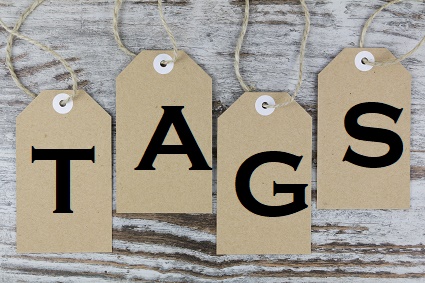Your cart is currently empty!

Using Tags in WordPress
WordPress tags show up at the bottom of the posts on your WordPress website, typically. The way they look will depend on your theme, but we’ve never built or seen a theme that doesn’t allow you to use tags. You can add them when you write your post, and they will provide your readers with additional help with navigation.
For example, if you read an article here at Haden Interactive on accessibility, you can click on the tag “accessibility” and find more articles on the subject, as shown in the screenshot below. Since we have over 1800 blog posts here, that tag is certainly going to be more useful than browsing around would.
I have to admit that we don’t focus on tags much here. However, I have a less-is-more philosophy when it comes to tags.
Tags: Doing It Wrong
Here’s an inspiring post on an unnamed website that uses four tags:
“Accessibility ready templates, Accessibility ready themes, Accessibility ready WordPress, Accessibility WordPress.” Do you really believe that this website has four distinct groups of articles with those four tags, and this one post happens to be at the intersection of the four? I don’t. This is an example of tagging with machines, not humans, in mind.
In fact, I clicked on all four of those tags and found only the one post — one total, with four tags, each showing that one post. That could be a frustrating experience for someone who wants to learn more about web accessibility.
The screenshot below shows a blog that lists all the tags in the sidebar. It’s an extremely long list, but you can see from the first few entries how many tags have just one post associated with them.
If you sort a bunch of things into groups and most of your groups have just one item, you’re doing it wrong.
I won’t show you a screenshot of a blog post with 17 tags on it, because we’ve all seen those, and we probably all know how useless they are. This isn’t hashtags on Instagram. It’s supposed to help people find the content they actually want to see.
Doing It Right
People misusing tags at their blogs are probably doing so because they’ve heard that tags help with SEO. They certainly can, just as all your content helps with SEO. But you have to think about your human visitors along with your spider visitors.
You can see from the search below that Google does index tag archive pages. Our analytics show us that people land on our tag archive pages via search, too. So use those tags — but use them in ways that will be useful to human beings. A strong tag archive page can provide a good experience for your human visitors as well as a good page for SEO.
One additional point: your website might use categories — the partner of tags — to determine which pages hold what content. If so, you might want to use tags in the places where you might otherwise use categories. You should still follow these simple rules:
- Use tags to group content into logical sets.
- Assume people will click on the tags and make sure that’s a good experience.
Tags? What tags?
Not sure where to add tags?
If you’re using the classic WordPress editor, you’ll find the tags in the right hand sidebar, below the publishing and category information. As you see below, you can click on “Choose from the most used tags” to see a list. This can help you avoid using “urinary tract infection” one time and “UTI” the next — that keeps your tags from doing the sorting and navigation job they ought to be doing.
As of this writing, the Gutenberg editor doesn’t provide that list, though it will offer suggestions while you type. I’ve pointed this out to the people working on the Gutenberg editor, so that may have changed by the time you read this.
The place for tags is in roughly the same spot on the Gutenberg editor screen as on the classic WordPress screen.
Just type in your tag or tags in those spots and when you publish, your posts will have the tags you chose.
If you have a web team, it makes sense to discuss tags and make some decisions on the best selection of tags for your content.







Leave a Reply